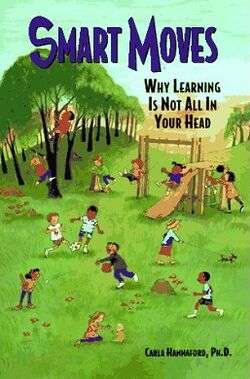Unsolved:Smart Moves
 First edition | |
| Author | Carla Hannaford |
|---|---|
| Country | United States |
| Language | English |
| Genre | Psychology; Learning |
| Publisher | Great River Books |
Publication date | 1995 |
| Media type | Print (Paperback) |
| Pages | 237 p. |
| ISBN | ISBN:0-915556-37-5 |
| OCLC | 32820701 |
| 612.8 20 | |
| LC Class | QP408 .H36 1995 |
The book Smart Moves: Why Learning Is Not All In Your Head was written in 1995 by neurophysiologist and educator Carla Hannaford (revised and enlarged second edition published 2005), and includes an introduction by neuroscientist Candace Pert.
In Smart Moves, Hannaford looks at the body's role in thinking and learning, citing research from child development, physiology, and neuroscience.[1][2] Hannaford examines the ways that sensorimotor experiences effect short- and long-term memory, from infancy through adulthood, and argues that movement is crucial to learning.
In her book, Hannaford offers alternatives to enhance learning ability. Included in the list are: de-emphasizing rote learning; more experiential, active instruction; less labeling of learning disabilities; more physical movement; more personal expression through arts, sports and music; less prescribing of Ritalin and other drugs whose long-term effects are unknown. She also details the roles in learning played by various areas of the brain, and examines the interplay of brain, body, and environment.
Hannaford is an advocate of movement and play in learning, discussing the importance of sensorimotor development (visual, auditory, tactile, and kinesthetic readiness) to the learning process. She provides several case examples of children whose learning improved remarkably through use of the Brain Gym activities, as well as including her own research done with Brain Gym.[3][4]
In Smart Moves, Carla Hannaford describes how emotions and the physiological stress reaction can affect the everyday lives of both children and adults. She invents the term SOSOH (Stressed Out, Survival-Oriented Humans) for people with learning disabilities or attention difficulties. She argues that ADD, ADHD, and all other learning problems are related to stress, as stress produces survival-oriented behavior while inhibiting the learning process.
Smart Moves proposes approaches to support learning, including:
- dietary awareness: drinking enough water, less sugar intake, etc.
- doing physical movement to help the brain perceive events in a less stressful way
- creating a more calm environment for people with learning difficulties
Many of the claims made in 'Smart Moves' refer to ideas that are now widely identified as 'neuromyths' (Dekker et al., 2012). Neuromyths are plausible-sounding assertions that often have a basis in a misunderstanding of neuroscientific ideas, or extrapolation of ideas beyond the context in which they are might legitimately be applied. In addition, 'Brain Gym' has been suggested to have no evidence-basis (Hyatt, 2007) and Hannaford's assertion that it is legitimate based on anecdotal evidence alone may confuse the situation for teachers and parents.
Carla Hannaford is also the author of The Dominance Factor: How Knowing Your Dominant Eye, Ear, Brain, Hand, & Foot Can Improve Your Learning (1997), Awakening the Child Heart: Handbook for the Global Parenting (2002), and Playing in the Unified Field: Raising and Becoming Conscious, Creative Human Beings (2010).
See also
- Stress: General adaptation syndrome
- Perceptual learning
- Vision training
References
- ↑ Podder, Tamushree (2004). Smart Memory. Pustak Mahal. pp. 89. ISBN 978-81-223-0759-7. https://books.google.com/books?id=A7sHCl0GQOYC&pg=PA89&dq=%22Smart+Moves%22+%2Bhannaford&num=100&sig=ACfU3U3gD-pBvrevngE_FpekpmRYd_uLdg. Retrieved 2008-09-13.
- ↑ Pica, Rae (2003). Your Active Child. McGraw-Hill Professional. pp. 82. ISBN 978-0-07-140558-4. https://books.google.com/books?id=jVg0GK3enPsC&pg=PA82&dq=%22Smart+Moves%22+%2Bhannaford&num=100&sig=ACfU3U0Q2K7RcJYExNmzMU0h2i4uEBJ26A. Retrieved 2008-09-13.
- ↑ Hannaford, Carla (2005) [1995]. "7 and 13". Smart Moves. Great River Books. ISBN 0-915556-37-5. https://books.google.com/books?id=A7sHCl0GQOYC&pg=PA89&dq=%22Smart+Moves%22+%2Bhannaford&num=100&sig=ACfU3U3gD-pBvrevngE_FpekpmRYd_uLdg. Retrieved 2008-09-13.
- ↑ Dennison, Paul, and Gail Dennison (1989, 1994, 2010) Brain Gym(R): Teacher's Edition. Hearts at Play, Inc. ISBN:0-942143-02-7

